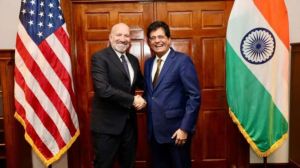UN urges quick climate action at world meet
Secretary general ban ki-moon opened a meeting of world leaders on climate change here on Monday stating that the scientific evidence...

Secretary general ban ki-moon opened a meeting of world leaders on climate change here on Monday stating that the scientific evidence of its global impact was sound and the moment to act was now. “Today, the time for doubt has passed,” he told delegates in the packed United Nations General Assembly hall.
Saying that “the scientists have very clearly outlined the severity of the problem”, he said their message was that the world knows enough to act, that failure to act will bring “devastating” consequences and that affordable technologies exist to start addressing the problem promptly.
“Inaction now will prove the costliest action of all in the long term,” he said.
The one-day debate on climate change, with more than 150 nations participating, was organised by Ban Ki-moon to prepare the ground for launching negotiations on an agreement to succeed the 1997 Kyoto Protocol, the international accord that limits the emissions of greenhouse gases.
More than 80 heads of state and government are expected to attend this week’s opening of the 62nd General Assembly session, which has adopted climate change as its central theme.
The United States rejected the Kyoto conclusions, and President Bush is not participating in the day’s meeting. Instead, he is coming to New York only this evening for a dinner of major national leaders hosted by Ban Ki-moon.
Bush, who opposes negotiated limits on greenhouse gases, has scheduled his own two-day climate meeting of 16 major industrial nations in Washington on Thursday and Friday this week at which he is expected to put forth his administration’s competing view that nations should be permitted to set their own limits rather than having them dictated by a binding treaty.
Secretary of State Condoleezza Rice was to present the United States case to the delegates in New York later on Monday, but another American with a conviction similar to Ban Ki-moon’s, California Governor Arnold Schwarzenegger, came to the podium shortly after the Secretary General finished speaking.
Under his leadership, California is promoting the kind of legal limits that the Bush administration opposes, and Schwarzenegger asserted, “It is time to come together in a new international agreement that can embrace the rich and poor nations alike.”
“California,” he pledged, “is moving the United States beyond debate and doubt to action.”
He added:. “The time has come to stop looking back in blame or suspicion. The consequences of global climate change are so pressing that it doesn’t matter who was responsible for the past, what matters is who is answerable for the future.”
He said the responsibility of all nations was “action, action, action, action.”
CLIMATE JARGON
• KYOTO Short for Kyoto Protocol, an international agreement adopted in 1997 in Kyoto, Japan, which sets binding targets for emission of greenhouse gases that spur global warming. Under this agreement, developed countries are to cut their emissions by an average of 5.2 per cent below what they were in 1990.
• FRAMEWORK The UN Framework Convention on Climate Change, a 1992 agreement that the United States and 191 other countries have signed. Like Kyoto, it seeks to keep greenhouse gases from hitting a level that would interfere with climate, but has no legally binding requirements.
• GREENHOUSE Chemicals that trap the sun’s heat near the Earth like a blanket. These substances include carbon dioxide, which is emitted by humans and all other creatures that breathe air. They are also emitted by coal-fired power plants and petroleum-fueled vehicles. They are not the most intense greenhouse gas — methane is 10 times more powerful in contributing to global warming — but carbon dioxide from fossil fuel consumption produces 82 per cent of the world’s human-generated greenhouse gases.
• CAP and TRADE Policy tool that sets limits on harmful emissions, giving allowances to affected industries and countries within these limits, or caps. Those with emissions above the cap can trade with those with emissions below it. Also known as emissions trading.
• CARBON FOOTPRINT A measure of the impact of human activities on the environment in terms of the amount of greenhouse gases they produce, measured in units of carbon dioxide.
• CARBON OFFSETS Paying to make up for carbon emissions. One example is planting trees or contributing to a wind farm to make up for the carbon dioxide emitted during air or car travel.
• MAJOR ECONOMIES The world’s biggest emitters of carbon dioxide. They are: the United States, China, the 25 countries of the European Union, Russia,
India, Japan, Brazil, Canada, Mexico, Indonesia, South Korea, Australia and South Africa.





- 01
- 02
- 03
- 04
- 05


























